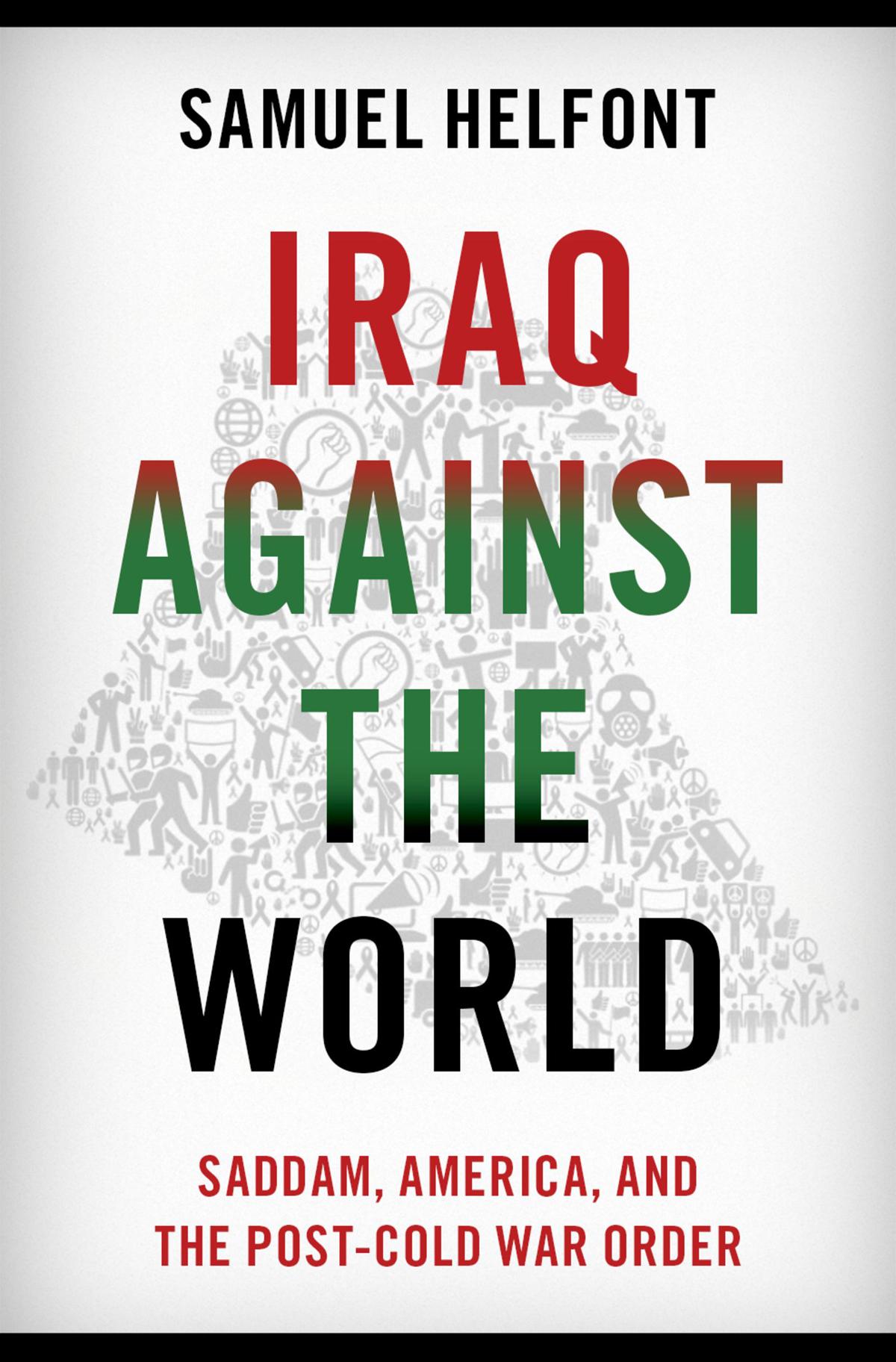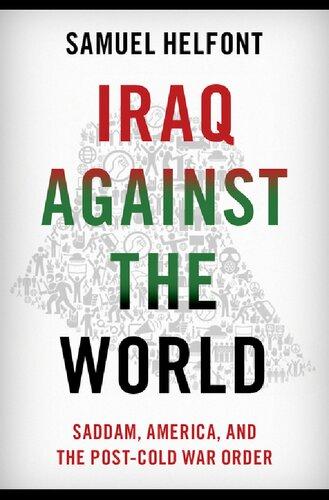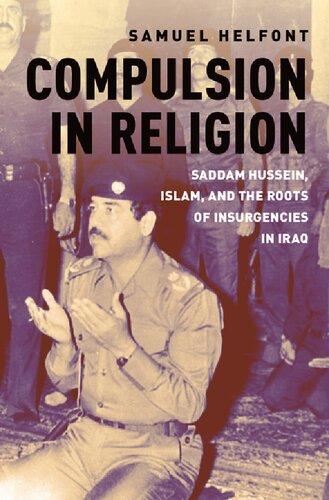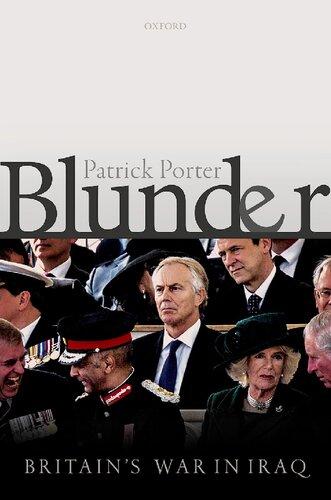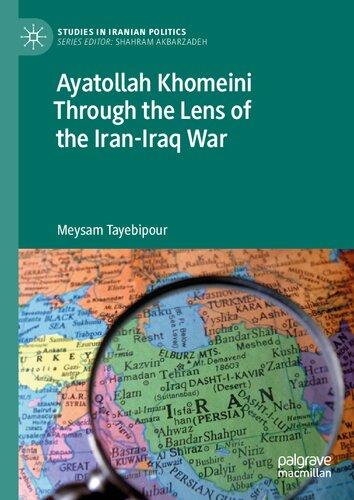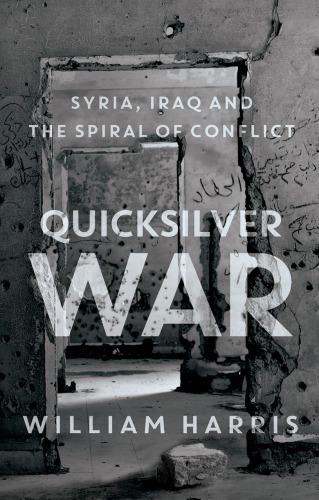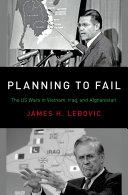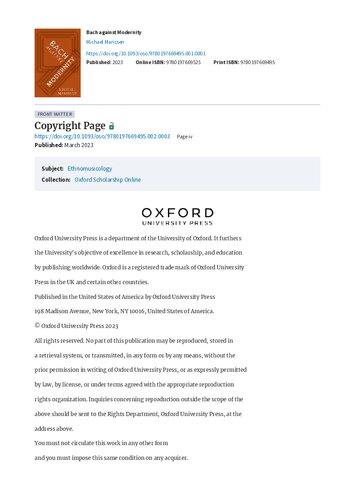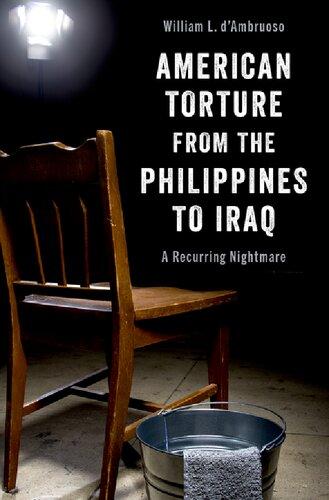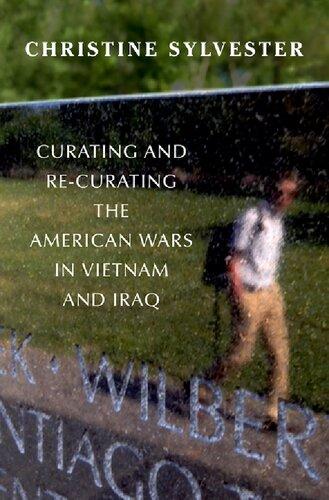Iraq against the World
SAMUEL HELFONT
Oxford University Press is a department of the University of Oxford. It furthers the University’s objective of excellence in research, scholarship, and education by publishing worldwide. Oxford is a registered trade mark of Oxford University Press in the UK and certain other countries.
Published in the United States of America by Oxford University Press 198 Madison Avenue, New York, NY 10016, United States of America.
© Oxford University Press 2023
All rights reserved. No part of this publication may be reproduced, stored in a retrieval system, or transmitted, in any form or by any means, without the prior permission in writing of Oxford University Press, or as expressly permitted by law, by license, or under terms agreed with the appropriate reproduction rights organization. Inquiries concerning reproduction outside the scope of the above should be sent to the Rights Department, Oxford University Press, at the address above.
You must not circulate this work in any other form and you must impose this same condition on any acquirer.
CIP data is on file at the Library of Congress
ISBN 978–0–19–753015–3
eISBN 978–0–19–753017–7
DOI: 10.1093/oso/9780197530153.001.0001
ToNadav,Edden,andTally
Contents
PrefaceandAcknowledgments
Introduction: Iraq and the World
1. Precursors
2. The Gulf Crisis and the New World Order
3. Triumph and Despair After the Gulf War
4. Building Networks in the West, 1991–2
5. Toward Influencing Policy in non-Western World, 1991–2
6. Courting Clinton
7. A Turning Point for the New World Order
8. Breaking Isolation
9. Normalization, 9/11, and the Road to War
Conclusion and Afterword: Saddam’s Iraq and Twenty-First Cent ury Disorder
Notes
Bibliography
Index
Preface and Acknowledgments
Like many Americans in academia, think tanks, the military, diplomacy, and the intelligence community, Iraq has played an outsized role in my life. One of the driving questions behind my research is, why? How did a midsized country on the opposite side of the world come to dominate American foreign policy and the lives of so many Americans for almost thirty years? Plenty of people have attempted to answer this question from the American point of view. That type of American-centric approach to international history is all too common, but it is also distorting. For me, Middle Eastern history and Middle Eastern perspectives have filled in gaps and corrected the sometimes-glaring errors in narratives based strictly on Western sources. Along those lines, this book attempts to add an Iraqi perspective to broader histories of the post–Cold War. In doing so, I hope it also will help readers to understand how Iraq came to play such an outsized role in international history over the past three decades.
This book has its origins in research that I conducted for my previous book. While working in the Ba‘thist archives at the Hoover Institution, I came across an organization that changed its name several times but usually went by something like the Iraqi Ba‘th Party outside Iraq. I was intrigued. No one that I knew had heard about this organization and none of the scholarly literature on Iraq mentioned it. Yet, in the Iraqi regime’s internal records, it played a prominent role. As I began reading this organization’s files, I quickly came to realize that it was a central feature of Iraq’s international strategies under Saddam Hussein’s regime. Its records offered profound and unprecedented insights into Iraq’s foreign policy, its worldview, and its clash with the international community in the final decade of the twentieth century. Several years of work with those
files provided a core around which I built the narrative for this book. I have added additional layers of research from other American, British, and United Nations archives as well as from private papers, memoirs, and the popular press. The result, I hope, will contribute not just to Iraqi or American history, but to international and global histories of the post–Cold War more generally.
I owe many people and institutions a great debt for supporting me through the process of writing this book. First, and most importantly, I need to thank my family. I wrote much of this book in 2020 and 2021 during the outbreak of COVID-19. My wife, Tally, and I found ourselves secluded in a small, two-bedroom apartment with a preschooler, Nadav, and a first-grader, Edden. The situation was challenging to say the least. Tally was also holding down a full-time job, but the pandemic had lightened her workload considerably. She graciously took the lead with the boys to carve out time for me to write. Often, I would walk up the street to my mother’s apartment, where she allowed me to set up an office in her guest room. The opportunity to write through the pandemic was a privilege many other scholars simply did not enjoy. Additionally, I am extremely lucky that Tally also possesses considerable background in Middle Eastern studies and American foreign policy. As such, she has been both my most important critic and my greatest supporter. She has read everything I have ever written, including multiple drafts of this book, and she has had to endure me droning on about the intricacies of Iraqi history over countless dinners, walks, and car rides. This book simply would not have been possible without Tally. I cannot thank her enough.
Outside my family, a number of people and institutions have been critical to the completion of this book. I began research for this project while still writing my dissertation under Bernard Haykel at Princeton University. Friends from Princeton like Aaron Rock-Singer, Simon Fuchs, and Cole Bunzel have remained an important network of support. Over the years I have also maintained a relationship with Tel Aviv University, where friends like Brandon Friedman, Joel Parker, Rachel Kantz-Feder, and Josh Krasna have been important sounding boards.
I really threw myself into this project during a three-year postdoc at the University of Pennsylvania in the International Relations Program headed by Walter McDougall. Other colleagues at Penn were excellent. Tomoharu Nishino accompanied me on three trips to the Middle East, two of which were to Iraq. Frank Plantan and Mark Castillo ensured I had all the resources I needed. Anna Viden and Mike Horowitz were always available if I needed to bounce ideas off someone.
While at Princeton and Penn, I was also a nonresident Senior Fellow at the Foreign Policy Research Institute, where I need to thank Alan Luxenberg, Barak Mendelsohn, Dom Tierney, Mike Nunan, Ron Granieri, and John Nagl for their friendship and support. I would also like to thank Cornell Overfield who was both my student at Penn and my intern at FPRI. He dedicated many months of research to this project. It would not have been the same without his enthusiasm and intellect.
I researched much of this book at Stanford University, where two institutions have been critical. The Abbasi Program in Islamic Studies provided a great deal of support. Its Director, Lisa Blaydes, deserves special thanks for her help through every stage of this project, including organizing a book workshop at the Abbasi Program in November 2021. At that workshop, I received valuable feedback from Alissa Walter, Ariel Ahram, Ruiheng Li, Shamiran Mako, David Patel, Larry Rubin, and Michael Brill, each of whom read and commented on my manuscript.
Also at Stanford I need to thank the Hoover Institution, which houses the Ba‘th Party archives and has been generous with its support for many years. In particular, I have benefited from several summer workshops organized by Paul Gregory. Eric Waken, who directs the library and archive has bent over backward to accommodate my needs, including allowing me into the reading room during renovations. Haidar Hadi has been a tremendous help in deciphering the labyrinth of Iraqi holdings at Hoover, and Sarah Patton was always available to assist with my needs.
Since 2018, I have been Assistant Professor of Strategy and Policy at the Naval War College, but permanently in residence at the Naval
Postgraduate School in Monterey. It would be hard to imagine a more collegial group of friends and colleagues (especially in academia!) than Mike Jones, Joyce Sampson, John Sheehan, Yvonne Chui, Craig Whiteside, Bob Tomlinson, Fred Drake, Jonathan Czarnecki, Misha Blocksome, Greg Reilly, and Karl Walling. Outside the Naval War College program, Chris Darton and Covell Meyskens of NPS’s National Security Affairs Department have been great friends and have had to listen to me talk about this project incessantly for the past several years. While in Monterey, I also benefited from the insights of Don Stoker and an FPRI intern Tamara Milic. In the Strategy and Policy Department at the Naval War College itself, I have always relied on insights, feedback, and support from John Mauer, Scott Douglas, and Tim Hoyt.
Outside these institutions, I need to thank Marc Lynch, Ryan Evans, and Doyle Hodges for providing platforms for me to share my work and for offering invaluable feedback on it. Steve Coll and Mel Leffler, who are each working on their own books about Iraq, read and provided valuable comments on this book, as did Kate TietzenWisdom and Daniel Chardell. Hal Brands helped with early framing of this work and commented on a copy of the book proposal. Although I already mentioned Michael Brill as a participant in the book workshop, he has done much more than that. He deserves special thanks for the constant and ongoing conversation we have had on Iraq.
I would like to thank everyone at Oxford University Press. This is the second book I have completed with Angela Chnapko as my editor and Alexcee Bechthold as the assistant editor. They have always been responsive to my needs and an absolute pleasure to work with.
Finally, while working on this project over the past few years, I have published some of my findings in the following articles and book chapter: “Saddam and the Islamists: The Ba‘thist Regime’s Instrumentalization of Religion in Foreign Affairs,” The Middle East Journal 68, no. 3 (Summer 2014); “Authoritarianism beyond Borders: The Iraqi Ba‘th Party as a Transnational Actor,” TheMiddle East Journal 72, no. 2 (Spring 2018); “The Gulf War’s Afterlife:
Dilemmas, Missed Opportunities, and the Post-Cold War Order Undone,” TexasNationalSecurityReview4, no. 2 (Spring 2021); and “Catalyst of History: Francis Fukuyama, the Iraq War, and the Legacies of 1989 in the Middle East,” in TheLong 1989: Decadesof Global Revolution, ed. Piotr Kosicki and Kyrill Kunakhovich (Central European University Press, 2019). I would like to thank the publishers for allowing me to draw upon and sometimes repeat arguments I made in those works throughout this book.
Introduction: Iraq and the World
“This is not, as Saddam Hussein would have it, the United States against Iraq. It is Iraq against the world.”1 George H. W. Bush spoke those words before a joint session of Congress on September 11, 1990. By invoking “the world,” Bush was not referring simply to the large number of countries he was assembling into the Gulf War coalition. As he made clear in the speech, Bush saw the war as an opportunity to birth “a new world order.” The Cold War was coming to an end, and in Bush’s words, “a new world is struggling to be born, a world quite different from the one we’ve known. A world where the rule of law supplants the rule of the jungle.” For its proponents, this new world would be the culmination of a centuriesold intellectual history rooted in utopian thinking about global peace and universal governance. It would be embedded in institutions of international law like the United Nations Security Council, which was designed to contain the might-makes-right calculations that had tortured the twentieth century.
The end of the Cold War marked a unique point in global history. It has been called a unipolar moment, Pax Americana, and even the “end of history.”2 One prominent analyst later described it as launching a period of “deep peace,” fulfilling the biblical prophecy in which “nation shall not lift up sword against nation, neither shall they learn war no more.”3 Of course, not everyone was swept away by what one historian called the “millenarian expectations” of the period and that dissent is critical to this book.4 Yet, whatever one makes of post–Cold War idealism, it was clear that after a decadeslong struggle, the United States emerged as the undisputed leader of global politics; not just a great power, or even a superpower, but a “hyperpower.”5
Bush had an unprecedented chance to shape the new world that he heralded in his speech to Congress, and he placed the recalcitrant
regime in Iraq at the center of his strategy to do so. Following the Gulf War, Bush continued to rally international support for building a new world order based on his policies toward Iraq. He touted experimental tools such as international sanctions, weapons inspections, and no-fly zones, which he hoped a newly unified Security Council could use to enforce its resolutions and contain Saddam. Many internationalists and peace activists shared Bush’s aspirations and hoped that employing these tools would be an important step toward ending interstate war altogether.
This was “the world” that Bush invoked, and this book unearths the untold story of how Iraq confronted it throughout the 1990s and early 2000s. The book relies on American, United Nations, and British records, as well as years of research in Arabic-language Iraqi archives. The results highlight previously unknown Iraqi strategies, including the prominent use of influence operations and manipulative statesmanship. In exploring these strategies, the book traces Ba‘thist operations around the globe—from the streets of New York and Stockholm, to the mosques of Pakistan and Saudi Arabia, and the halls of power in Paris and Moscow. In doing so, it highlights the limits of Bush’s new world order. It also offers new insight into Iraq’s attempts to influence the evolution of post–Cold War politics, the fallout of which continues to shape our world today.
Attempts to Influence the Post–Cold War World
Saddam’s goals in confronting the post–Cold War world were clear. Iraq was being smothered under harsh UN sanctions and invasive weapons inspections; the Ba‘thists wanted to end them while offering as few concessions as possible. Saddam saw these sanctions and inspections as tied to an emerging world order. Thus, he thought that breaking up the newly forming international system was the key to Iraq’s salvation.
Following the Gulf War, Iraq’s military and diplomatic options were limited. Instead, it developed deeply intertwined political and
economic strategies to influence global politics. Until a UN “oil-forfood” program allowed the regime to begin selling its oil in 1996, economics remained an important but mostly latent force in Iraqi foreign policy. As such, in the early-to-mid-1990s, Ba‘thist records highlight what Western analysts would call Baghdad’s political “influence operations” and what the Iraqis called al-taharruk (literally, moving someone). These operations were far more extensive than anyone outside the Ba‘thist regime understood. The Ba‘th Party and the Iraqi Intelligence Service embedded themselves in Arab diasporas and worked from Iraqi embassies around the world. They attempted to shape political discourse in and among key states and they organized disparate constituents in foreign countries using a combination of moral and political persuasion.
By the mid-1990s and then even more so after the oil-for-food program went into effect in 1996, the Ba‘thists incorporated economics into their influence campaigns. The political and economic aspects of Iraqi strategies reenforced one another. Party branches around the world and the Iraqi Intelligence Service identified actors who would assist the regime in circumventing or degrading sanctions. Iraq had one of the world’s largest proven oil reserves, and as the United Nations’ independent inquiry later noted, Saddam’s regime “was willing to forego revenue from oil sales or to overpay for imports to reward or encourage certain foreign politicians, journalists, and businesses to exert influence in its favor, . . . especially in advocating a lifting of the sanctions.”6 Thus, politicians, states, and corporations benefited by supporting Iraq’s strategic initiatives. At the same time, Ba‘thists continued to amplify narratives around the world that emphasized the suffering of innocent Iraqis from international sanctions. Such narratives shaped media coverage about Iraq and provided political cover for those who stood to benefit economically from supporting Iraq. Therefore, while much has already been written about Iraq’s manipulation of the oil-for-food program, previously unexplored Iraqi archives show how such economic operations were integrated into and dependent on broader political strategies.
The Ba‘thists who carried out these operations were quite colorful and often corrupt. People like Huda Salih Mahdi Ammash, who the Western press dubbed “Mrs. Anthrax” and “Dr. Germ,” coordinated with Iraqi intelligence officers who lived seemingly normal lives, running kebab shops in American suburbs while also spying on top secret military facilities. At their height, such Ba‘thists operated organizations in over sixty countries. Outside Iraq, the Ba‘thists were ideologically agile. They worked with people and groups that had little in common with the regime in Baghdad except for the fact that they opposed war and sanctions on Iraq. Thus, the Ba‘thists worked covertly, using proxy organizations and disassociating with the Iraqi embassies “to provide cover for their [Ba‘th] Party activities.”7 They courted people on both the political left and the right: academics, student organizations, militant Islamists, pacifists, liberal activists, and conservative isolationists. They found allies in the media and even among some mainstream politicians. Then, they attempted to bring these incongruent groups together into a loosely organized political force designed to achieve Iraq’s strategic goals.8
Rethinking Iraqi Foreign Policy under Saddam
Ba‘thist foreign policy focused on influencing politics in foreign states. While often neglected by diplomatic and military historians, this type of strategy has a long history. Political and military leaders have been using some form of influence operations since ancient times. As Sun Tzu famously argued, “to subdue the enemy without fighting is the acme of skill.”9 In Shakespeare’s Coriolanus, the Roman general for whom the play is named touted his ability “to take in a town with gentle words.”10 However, the type of highly politicized approach to international strategy that typifies modern influence operations has its origins in the American and French Revolutions when the masses revolted against their leaders. As Lawrence Freedman notes, the realization that such uprisings were possible led to the emergence of “professional revolutionaries,” who developed theories and tactics for fomenting unrest and mobilizing
society toward political ends.11 By the mid-nineteenth century, an early socialist leader in Russia named Alexander Herzen described the ideal professional revolutionary as someone possessing a “passion for propaganda, for agitation, for demagogy, if you like, to incessant activity in founding and organizing plots and conspiracies and establishing relations and in ascribing immense significance to them.”12 One would struggle to find better words to describe Iraqi Ba‘thists operating around the world in the 1990s and early 2000s.
As these professional revolutionaries emerged, states quickly grasped the benefits of sponsoring and fomenting them among their adversaries. In World War I, the perfect storm of mass mobilization of European societies and new communication technology led to a bonanza of propaganda aimed both at domestic and foreign populations. After the war, European states institutionalized their influence operations, and their propaganda grew increasingly sophisticated.13 The importance of influence operations paralleled what Hannah Arendt described as the rise of the age of “mass man,” in which the downward push of political agency meant the masses could be manipulated to great political effect.14 These developments reached their zenith in the Cold War when Soviet and American agents battled to destabilize each other’s states from the inside out.1 5 The father of America’s Cold War containment strategy, George Kennan, developed what the Americans called “political warfare” in the 1940s and 1950s.16 On the other side of the Iron Curtain, a former head of Soviet intelligence claimed influence operations, which the Russians termed “active measures,” were “one of the most important functions of the KGB’s foreign intelligence service.”17 Influence operations are inherently difficult to study even many years after they occur. They are often covert or clandestine. Scholars only know the full extent of Soviet operations because a KGB archivist named Vasili Mitrokhin spent thirty years secretly copying files in handwritten notes which he stored under the floorboards of his dacha, and then defected with them to the United Kingdom in 1992.18 By far the best archive of influence operations in the post–Cold War period comes from the Ba‘th Party documents, which
provide unprecedented insights into how a recent, illiberal, revisionist actor planned and executed its international operations.19
Strategies that rely on influence operations have been a consistent blind spot in international history. Some theories of international relations insist that power can only stem from material forces such as the military or economics. As such, Western analysts have often failed to recognize revolutionary political strategies and influence operations in international politics. George Kennan famously warned in his “long telegram” and “X” article that Western analysts who saw Stalin’s Soviet Union simply as a military threat akin to Napoleon or Hitler had misinterpreted Moscow’s worldview and its strategy. The Soviets, according to Kennan, had no intention of storming into Western Europe behind the Red Army. They expected to win the Cold War by attacking and undermining Western states politically.20
The same Western biases that Kennon criticized have also shaped the scholarship on Iraqi foreign policy under Saddam. Western analysts have tended to focus on what they think is important: the military, high diplomacy, and economics. Those were important elements of Iraqi power under Saddam—after all he used his oil wealth to build a large army, then to invade two of his neighbors, and he dreamed of leading Arab armies into Jerusalem. While not ignoring military officers and diplomats, this book puts more emphasis on political and economic elements of Iraqi strategy. Partly, this focus stems from the book’s sources. Records from the Iraqi Intelligence Service and the Ba‘th Party survived the 2003 war. The records from the Iraqi Foreign Ministry, which undoubtedly would have emphasized more traditional forms of diplomacy, did not.
However, even without relying on skewed sources, a careful study of Ba‘thist Iraq would reveal that the military and traditional diplomacy were not the primary lenses through which Saddam viewed international politics. He was a populist and he attempted to achieve his goals by influencing the masses. Saddam owed his power to his place within a populist, self-described revolutionary political party. He did not rise through the ranks of the military or
state security services. As one of his biographers noted, “for all the uniforms, titles, and honorary ranks . . . Saddam never had any military experience, had probably never read a military textbook, or even considered the finer points of strategy and tactics.”21 In fact, the Ba‘thist regime that he ruled had a history of turbulent relations with the Iraqi military and other state institutions. A short-lived Ba‘thist coup in Iraq had gone awry in 1963 when military officers turned against the party. Therefore, immediately after they took power in 1968, the Ba‘thists purged Iraqi military and intelligence officers, replacing them with political activists who were loyal to the party. It should come as no surprise, then, that Saddam saw the party rather than the military as the source of his power, and throughout his life, he tended to view the world through the lens of its populist politics.
It was also no coincidence that many of what might be called quintessentially Saddamist institutions were described as “popular.” When Saddam needed a loyal militia to defend his regime in the 1970s, he created the “Popular Army.” When he wanted to mobilize international Arab support, he held the “Conference of the Popular Arab Forces.” When he wanted to mobilize Islamic opinion, he organized the “Popular Islamic Conference.” The word popular in these instances is a translation of the Arabic term sha‘bi. It suggests something coming from the masses, unofficial, and of the people. And even Iraqi sources from outside the Ba‘th Party show that when the regime engaged in international politics, it saw populist efforts as its natural source of strength. For example, when attempting to influence international Islamic opinion during the war with Iran, the Iraqis distinguished between official (rasmi) and popular (sha‘bi) efforts. The Iraqis considered other states to be more adept in pursuing the official track; Saddam’s regime focused on the populist track, which is why it organized the Popular Islamic Conference.22 This view of the importance of popular mobilization in international politics was not limited to Islam and it remained an important part of Iraqi strategy until the end of Saddam’s rule in 2003.23
Saddam’s foreign policy was also influenced by a Middle Eastern geopolitical context in which conventional warfare and decisive battles have played a much smaller role in shaping states than they have in other regional systems, most notably in Europe. Since the nineteenth century, outside powers repeatedly intervened to prevent any Middle Eastern actor from achieving the type of decisive military victory necessary to become a great power.24 Modern Middle Eastern states still had interests, but they have relied on influence operations and political warfare to achieve their goals. Throughout the middle decades of the twentieth century, radical Arab nationalists like the Ba‘thists and Nasserists sponsored revolutionary parties across the region and filled international airwaves with their propaganda. Their adversaries returned the favor by supporting Islamists revolutionaries within their secular Arab republics.25 Saddam exported these Middle Eastern strategies to the global arena.
Operational Influence, Strategic Influence, and World Order
This book’s main contribution is its reconsideration of Ba‘thist Iraq’s foreign policy and its unearthing of previously unknown Iraqi strategies. However, a secondary and more speculative argument about the impact of those strategies on world order has important implications for international and global history. While most histories of the transition from Cold War to post–Cold War focus on Berlin, Eastern Europe, and Moscow, this book highlights how the post–Cold War was also negotiated, built, and ultimately undermined in Iraq. The book does not argue for a reduction in the significance of those other places in post–Cold War history. It simply attempts to place Iraq alongside them.26 In doing so, it also upends the typical method of using Western archives to write histories of the Middle East. Instead, this book looks to Iraqi archives for insights into the histories of places like Russia, Western Europe, and the United States.
Internal Iraqi records contain thousands of pages on Ba‘thist attempts to influence global politics. As such, describing Ba‘thist strategies and operations is fairly straightforward. A more difficult but also more consequential question is: Were they successful? Answering that question requires distinguishing between what one might call operational level impacts and strategic level impacts. The former is fairly easy to analyze; the latter is more problematic.
On an operational level, the Ba‘thists were successful when they were able to partner with the types of people and organizations that were necessary to execute their influence campaigns. They needed to work with and through foreign political parties, religious organizations, the media, unions, and so forth. Thus, measuring the effectiveness of Iraqi influence campaigns at this level is not too difficult: Either the Ba‘thists found partners or they did not. Iraqi records make clear that throughout the 1990s and early 2000s, they were quite successful at this operational level.
In contrast to this rather straightforward analysis, determining whether the Ba‘thists were able to transform operational gains into strategic impacts is more difficult and probably impossible. Success on the strategic level requires one to consider whether Ba‘thist actions actually affected international politics in a way that aligned with Iraqi interests. The problem, as one scholar of Cold War influence operations has argued, is that influence operations work best when based on “existing conflicts and existing divisions.”27 Thus, separating their strategic effects from what would have occurred in their absence can be quite difficult.
States, organizations, and people act based on their interests and values. Iraqis could not change those fundamentals. However, this book asserts that Iraqi actions could affect policies and political decisions on the margins. That type of influence can still be quite important because political disputes are often won or lost on the margins. To take a more recent example, the well-documented Russian attempt to influence the 2016 American presidential election did not create the racial and postindustrial economic discontent that buoyed Donald Trump’s campaign. If the Russians were successful in
influencing the election—and as with other influence operations, that proposition is difficult to prove—they did so by amplifying and channeling this existing discontent. Theories that Moscow’s actions affected the outcome of the election rest on the claim that Russian influence operations drove a tiny fraction of national voters to the polls who otherwise would not have voted. When concentrated in a few key states, these extra votes put Donald Trump in the White House and changed the trajectory of American politics.
Likewise, a group like the Muslim Brotherhood, or states like Russia and France, were poised to resist American hegemony in the 1990s. However, this book presents evidence that Iraq pushed these actors to contest the American-led order in a manner that significantly inflamed preexisting tensions. Moreover, Iraq was not necessarily going to be at the center of struggles between these actors and the United States. Baghdad’s actions ensured that it would be. Thus, while Iraqis could not alter the fundamentals of international politics, this book makes a case that they were able to influence the shapeand scaleof post–Cold War tensions in a manner that had a lasting effect on the international system.
Much of this argument rests on Iraq’s role in fracturing consensus at the United Nations Security Council. It is worth emphasizing that George H. W. Bush, not Saddam, put Iraq at the center of a new world order. As recent scholarship has shown, Saddam was clearly thinking about the end of the Cold War when he invaded Kuwait, but there is little evidence to suggest that he had a broader plan to challenge post–Cold War politics on a global scale.28 Nevertheless, following the Gulf War, Iraq stood almost alone against the international system that the United States attempted to impose. In the wake of the Cold War, the permanent members of the UN Security Council initially placed a high value on unity. Doing so gave them tremendous power in the newly cooperative international system. The Security Council’s first action in this new phase was to demand painful concessions from Iraq during and after the Gulf Crisis. Thus, Iraq became a test case for a new global order. Rather than comply, Saddam adopted what political scientists would
recognize as a classic “wedging” strategy to divide one’s adversaries.29 He attempted to lure states out of the coalition that had formed against him and to break the unity at the Security Council which underpinned it.
Beyond the Security Council, proponents of the post–Cold War order argued that a rules-based system could only operate through broad, collective action in global politics. Lesser powers had to see the American-led order as beneficial, or they would simply ignore the dictates of the Security Council.30 The Ba‘thist almost instinctually understood this reasoning and how to attack it. So, in addition to trying to divide the Security Council, Iraqis waged intense political battles for support among lesser powers in places like the Middle East and Western Europe.
Iraq’s strategies undermined the type of liberal norms that were necessary for a rules-based international system to function.31 Where leading states in the system committed to cooperation, the Iraqis sowed dissent; where these states committed to a rules-based system, the Iraqis enticed them to break the rules. In doing so, the Iraqis helped prevent these norms from crystalizing.32
Besides Iraq, other factors such as the Balkan wars, NATO expansion, failed humanitarian interventions, and disillusionment with economic globalization also undermined the post–Cold War system. Yet, because of the Gulf War, Iraq was entangled in the concepts of world order and even the idea of history itself in a way that, say, Somalia, was not. As such, the evolution of ideas about order and history in the post–Cold War period was disproportionately influenced by conflicts over Iraq.
The transformation of global politics that occurred over the last decade of Saddam’s rule was stunning. In 1991, the world was united in its opposition to Iraqi belligerence. Ten years later, Iraq divided not only the world, but also Western allies such as the United States, France, and Germany. Moreover, tools such as sanctions, inspections, and no-fly zones, which had been heralded as humanitarian alternatives to war in the early 1990s, were considered extreme and unjust by much of the world a decade later. Again, Iraqi
actions did not—and could not—create the fundamental tensions that drove this evolution. However, the Ba‘thists could shape and exacerbate the way those tensions manifested, and they did so to lasting effect.
Ba‘thist Iraq in History
Like the international order that Saddam hoped to challenge, Iraq had its own deep history that shaped its interaction with broader transnational trends. Though the intellectual power of Arab nationalism and Ba‘thism were fading in the 1990s, they continued to provide an ideology and, just as importantly, a structure around which the Iraqi regime was organized. Likewise, the Cold War was over, but vestiges of Third Worldism and nonalignment lingered, eventually transforming into resistance against global American hegemony. The rise of Islamism in the last decades of the twentieth century filled the ideological void left by the end of the Cold War in shaping political debates across the Muslim World. Finally, mass migrations to the West from Iraq and the Arab World provided challenges for a closed authoritarian regime like Ba‘thist Iraq, but they also provided new opportunities for Baghdad to influence international politics. These national, transnational, and international histories intersected as Iraq developed strategies to resist the dictates of the post–Cold War order.
Likewise, this book sits at the intersection of several streams of historical literature on Saddam’s Iraq. Over the past decade, the historiography of Ba‘thist Iraq has been revolutionized by an abundance of archival material that became available following the fall of Saddam’s regime. Yet, clear divisions have emerged in this literature, largely based on the object of their study and the different type of Iraqi archives that they used. One group of historians has produced what Fanar Haddad called the “new generation” of archive-based studies relying on the millions of pages of Ba‘th Party files at the Hoover Archives along with a wide range of other Arabic language sources to reconstruct the history of Saddam’s Iraq.33
Almost all the works in this category have focused on Iraq’s domestic social and political history.34
Alongside these works, another stream of literature focusing on international history and strategic studies has emerged out of research with translated Iraqi state records.35 Like the “new generation” of domestic histories just mentioned, these works on international and strategic studies have revolutionized what scholars know about Iraq. They have dissected critical issues like Iraqi weapons of mass destruction programs (or the lack thereof); they have provided deep insight into the decisions and ruling strategies of senior regime officials. Yet, these works have mostly been produced by generalists rather than Arabists. Therefore, they do not use the extensive but untranslated Ba‘th Party records at the Hoover Archives. The latter files provide critical details on the development and execution of Iraq’s international strategies. They enhance, and sometimes challenge much of the present literature on Iraq by shifting the focus away from what Western analysts consider traditional elements of power like the military and diplomacy, and instead point historians toward more politicized strategies, which as this book argues, were better aligned with Iraq’s history and worldview.
In essence, then, the archive-based literature on Ba‘thist Iraq falls into two rough categories: first, works that used a full range of Arabic sources—including the Ba‘th Party records—but have focused mostly on domestic social and political history; second, works that deal mostly with international history and strategic studies, but have been limited to English language sources. Iraq against the World bridges the gap between these two literatures. Like the “new generation” of Iraqi histories, it will use a wide range of sources in an attempt to develop a rich and nuanced narrative on Iraqi social and political history. Yet, it will apply that approach to broader international and strategic issues that have, thus far, mostly been covered only by generalists lacking access to the full range of sources on Ba‘thist Iraq.
